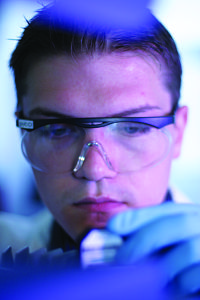Pharma partnerships promise big advances for personalized therapies
By Gary Tufel
Companion diagnostics are tests that provide information about a patient’s genetic and genomic characteristics, and are in turn used to guide decisions about treatment with specific drugs. FDA further describes companion diagnostics as medical devices that identify or determine a condition of use for a therapeutic product. In use, such assays identify specific protein and genetic makeups that define the optimal therapeutic treatment for a patient.
[reference float=”right”]
Companion Diagnostics, Defined
- Companion diagnostics are IVDs intended to assure that certain therapeutic drug or biological products are used in accordance with their labels to achieve approved safety and effectiveness. (“The drug depends on the diagnostic.”)
- Companion diagnostics are also devices that are claimed by the manufacturer or lab to select a population for treatment benefit, but which are not recognized by the drug sponsor in the drug label, and have not been reviewed by FDA for such claims.
- Companion diagnostics are or will be usually listed as “required” in the drug label to determine appropriate patient and drug selection.
- Codeveloped companion diagnostics are combination products.
- The primary mode of action is generally considered to be the drug.
- Diagnostic information is in the drug submission.
[/reference]
The relatively recent phenomenon of using companion diagnostics to guide treatment has proven so highly effective that it has spawned a significant increase in pharmaceutical companies partnering with diagnostics firms to develop and produce such diagnostics—and thus more targeted and effective treatments.
Drug developers determine patient populations who are more or less likely to respond well to a specific drug or therapy, and those who may have negative side effects from those treatments. Companion diagnostics provide a method of refining a patient’s diagnosis in order to get the information necessary to achieve the most likely and successful therapeutic intervention.
Partnerships between pharma companies and diagnostics firms for the purpose of developing companion diagnostics are on the increase. The resulting products are already contributing greatly to improved outcomes for patients, particularly in oncology.
But the increasing use of diagnostic tests to guide therapeutic selection is not limited to oncology. In the future, the trend will likely expand into other areas as the technology advances and next-generation sequencing becomes faster and less expensive.
SEQUENCING’S GREAT LEAP FORWARD
In 2003, when the human genome’s three billion molecular pairs were first fully transcribed, or sequenced, the total cost of the project was $2.7 billion. The earliest genomes to be sequenced each cost hundreds of millions of dollars.
But this January, Illumina, San Diego, announced that its newest sequencing system would be able to reduce the cost of a fully sequenced human genome to just $1,000—a number that payors might consider acceptable in regular clinical use. The new system—termed HiSeq X Ten—actually links together 10 of Illumina’s HiSeq X instruments, and carries a price tag of $10 million. According to Gregory S. Heath, PhD, Illumina’s senior vice president for in vitro diagnostics, the system can transcribe as many as 18,000 human genomes a year.
Heath notes that companion diagnostics have been revolutionary in increasing the response to therapies, particularly in treating cancer. By identifying the genetic mutations associated with disease at the molecular level, patients can be treated with drugs that the testing determines will work best. “Next-generation sequencing can scan tumor samples from a large number of people, and from them select a population of patients that need to be treated in specific ways, not only improving response rates but avoiding side effects from incompatible treatments,” Heath says.
Companion diagnostics are also being used more widely in areas outside of cancer, Heath notes. For instance, Kalydeco is being used to treat patients with cystic fibrosis (CF) aged 6 years and older who have been identified as having G551D mutation in their CF gene.
Taken together, the increased effectiveness of sequencing technologies, decreased costs of sequencing, and willingness of FDA to give regulatory approval for diagnostic sequencing are enabling clinicians to target patients with precisely the right treatment for each.
AN UNCERTAIN ENVIRONMENT
Meanwhile, partnering companies involved in developing companion diagnostics face an uncertain regulatory environment. In July 2011, FDA issued a draft guidance document on In Vitro Companion Diagnostic Devices, which remains available via the website of FDA’s Center for Devices and Radiological Health (CDRH). But according to Elizabeth Mansfield, PhD, director of the personalized medicine staff in the agency’s Office of In Vitro Diagnostics and Radiological Health, that guidance document remains in draft status “with no projected finalization date at this time.”
When that guidance document is completed, says Heath, it will have implications for both regulatory affairs and reimbursement.
The use of a companion diagnostic to guide the use of a particular therapeutic product can be stipulated in any of three ways, Heath explains. It can be in the instructions for use of the diagnostic device; in the labeling of both the diagnostic device and the corresponding therapeutic product; or in the labeling of any generic or biosimilar equivalents of the therapeutic product.
But if the instructions for use of the therapeutic agent specify the use of a particular diagnostic—say, Roche’s cobas 4800 BRAF V600 Mutation test to detect the BRAF V600E mutation—the use of any other test could be considered off-label and could be problematic for reimbursement.
Other instructions may be less specific, and therefore less likely to encounter regulatory or reimbursement issues, says Heath. For example, instructions to identify a particular genetic mutation might permit suitable tests to be selected from a series of specified brands, or might permit testing to be carried out via any test for that mutation.
THE KEY TO PERSONALIZED MEDICINE
A new breast cancer chemotherapy response assay by Almac Diagnostics, Souderton, Pa, was designed to aid clinicians in their patient treatment decisions by giving an indication of the patient’s likelihood of responding to anthracycline/cyclophosphamide therapies. But the test developed by Almac’s R&D team is not linked to a specific branded drug.
“The biology we have discovered predicts response to DNA-damaging drugs—and there are many novel DNA-damaging agents in development,” says Austin Tanney, PhD, scientific liaison manager at Almac. “It is a fair hypothesis that this signature will work as a companion diagnostic for such DNA-damaging agents, so Almac has an interest in pursuing this further.”
In addition to conducting R&D for its own products, Almac also offers a service business that focuses on the discovery, development, and delivery of biomarkers. On this side of the company, Tanney says, Almac runs biomarker testing starting as early as phase I for trial enrichment, and continuing right through to full companion diagnostic development.
Tanney believes that pharma-diagnostics partnerships are playing key roles in advancing the vision of personalized medicine. “It is through the development of companion diagnostics that we are able to personalize patient treatment decisions,” he says. “Partnerships are necessary, as the pharma industry is not set up to develop diagnostics. Partnering allows both the pharma and the diagnostics companies to focus on their strengths, and to develop their two products optimally.”
The use of companion diagnostics enables clinicians to select patients who are most likely to respond to a therapy, or to exclude patients likely to have negative responses. This is of clear benefit to patients, says Tanney, as it ultimately leads to more personalized treatments and reductions in toxicity. And the pharmaceutical industry ultimately benefits as well, as companion diagnostics lead to better drugs that will have better market penetration and better-protected long-term sales.
There has been a clear increase in the number of pharma-diagnostics partnerships, says Tanney. “In our business we have seen a very significant increase. This can also be clearly seen in the trade press, where there are regular announcements of such partnerships. And we know from our own experience that the public announcements are merely the tip of the iceberg.”
What’s fueling such growth in the field of companion diagnostics? Tanney thinks there are a variety of factors at play.
“One of the main drivers is clearly patient and clinician demand for better drugs,” he says. “It has been known for many years that, across the board, efficacy rates for drugs are far from perfect. In diseases such as depression, for instance, selective serotonin reuptake inhibitors (SSRIs) have an efficacy of around 50%. In oncology, it is not unusual for efficacy rates to be as low as 25%.
The big problem isn’t that the drugs don’t work, says Tanney. “The therapies clearly do work; we are just unable to identify which patients a given therapy will work for.”
There is also a competitive element at play. Pharma companies clearly want to develop better drugs. But if one company is developing a drug without a companion diagnostic, and its competitor is developing a drug for the same indication but with a companion diagnostic, chances are good that the competitor’s drug will work and have better efficacy on a selected population. “In this regard, the growth of the companion diagnostics field is essentially fueling itself,” Tanney says.
Companion diagnostics are ultimately the key to personalized medicine, says Tanney. Treatment regimens based on a better understanding of the molecular basis of the patient’s disease will lead to improved responses that benefit patients, healthcare providers, and ultimately, society as a whole.
Since much of this is new territory, how are companies identifying and preparing for challenges in obtaining regulatory approvals, achieving clinical adoption, or getting reimbursement coverage (and payment)?
Tanney says the field is clearly still evolving, and there is no single clear model in place. “We in the industry are working in partnership with all of the key players to find the best way forward for the development, regulation, and reimbursement of companion diagnostics.”
IMPROVING PAYOR OUTCOMES
Another recently announced partnership, between Johnson & Johnson and Seattle diagnostics firm Adaptive Biotechnologies, pairs the two companies in a biomarker discovery program designed to identify patients with certain diseases, including cancer, who are most likely to respond to targeted therapies. Adaptive president and CEO Chad Robins says the firms’ partnership is representative of the marked increase in such pharma-diagnostics partnerships across the industry, and for good reason: the benefits provided by the resulting technologies are profound.
Robins notes that every pharma company now has a senior vice president of biomarker discovery, a position that has gained importance over the past decade. “Pharma is investing heavily in the search for predictive ways to match patients with the right drugs, and Adaptive’s technology is generating data to help pharma achieve this goal,” he says. Such agreements are going a long way toward providing pharma companies with the insight they need to identify predictive biomarkers of response—that is, knowing which drugs are more likely to benefit particular patients, and why.
In cancer research, there has been a surge in the development of immuno-oncology drugs—agents that target or harness the body’s own immune system to fight cancer. For such drugs, Adaptive’s immunosequencing technology, immunoSEQ, enables investigators to examine the immune systems of cancer patients to identify biomarkers of response. Specifically, immunosequencing can be applied to tissue or blood cells and can help measure a patient’s immune reaction to both the tumor and the treatment.
“Our preliminary data show that for immuno-oncology drugs to be effective, there has to be a pre-existing host response to cancer; that is, the body must already be fighting the cancer,” says Robins. “The ability to work with pharma companies will expand our patient population, so that the data will hopefully mature into a truly predictive test to best direct patients to the right drug at the right time.”
Robins observes that immuno-oncology drug trials that employ a diagnostic to measure immune response and select patients may have higher response rates, thus expediting the development of the drug. Equally important, exclusion of patients who are unlikely to respond will eliminate the costly administration of these new drugs and the unnecessary immune-mediated side effects. Ideally, these patients will be redirected immediately toward other new classes of drugs being developed.
Robins also believes that partnerships between pharma and diagnostics firms will lead to better outcomes for the payor community by ensuring that costly new drugs are given to the people who are most likely to benefit, creating an intersection of patient health benefit and economic benefit.
“Companion diagnostics is no longer an emerging discipline, and pharma-diagnostics partnerships are no longer an emerging trend,” says Robins. “They are both validated, mainstream, and necessary techniques.”
[reference id=”36693″]RECENT PHARMA-DX AGREEMENTS[/reference]
A PREVIEW OF THE FUTURE
Illumina’s Heath expects that the growth of companion diagnostics will continue across therapeutic areas as pharmaceutical companies leverage the FDA-cleared MiSeqDx sequencer and begin to develop molecular diagnostic tests that use next-generation sequencing.
But current trends are really just the beginning of even more widespread use of companion diagnostics, in the direction of what Heath calls “companion therapeutics”—where broad molecular diagnostic panels will lead to tumor classification to guide therapeutic decision-making—including the selection of clinical trials. For example, Health says, the BRAF V600E mutation is often found in melanoma; but if the mutation is found in a colorectal cancer tumor using genomic sequencing, the patient could potentially benefit from being treated with a melanoma drug for that mutation.
Heath expects that cancer care will follow a similar trajectory to the treatment of HIV in the 1980s, when a single drug was used to treat the disease before an array of drugs was discovered to be effective. “This kind of evolution of treatment is the future,” he says. “As the population ages, oncology will be a real area of opportunity, because deep sequencing techniques are well suited to understand heterogeneity in cancer tumors.”
Heath cites recent testing advances in the area of cell-free DNA as an example of future trends. Verinata Health, an Illumina company, offers a simple, early blood test using cell-free DNA for detecting fetal chromosomal abnormalities—including those for Down syndrome, Edwards syndrome, and Patau syndrome—with high degrees of specificity and sensitivity. In the future, a similar process could identify cell-free DNA from tumors.
“This is a preview of the future,” says Heath, “when your routine physical exam could also include a cancer screening blood test.”
Gary Tufel is a contributing writer for CLP. For further information, contact chief editor Steve Halasey at [email protected].










